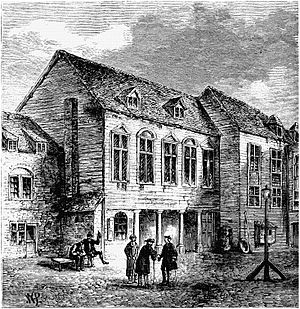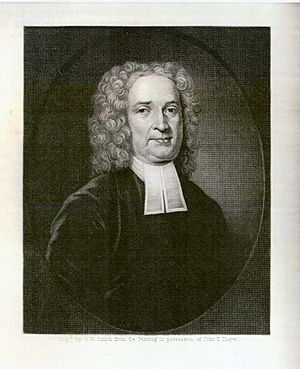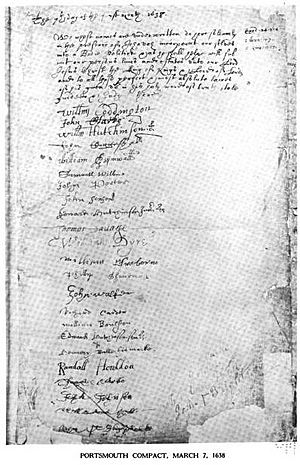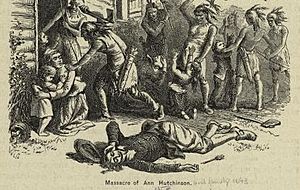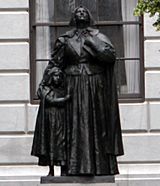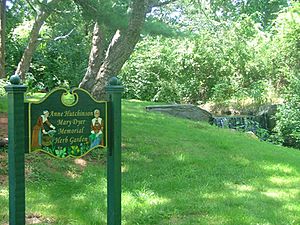Anne Hutchinson facts for kids
Quick facts for kids
Anne Hutchinson
|
|
|---|---|

Anne Hutchinson on Trial
by Edwin Austin Abbey |
|
| Born |
Anne Marbury
Baptised 20 July 1591 |
| Died | August 1643 (aged 52) New Netherland (later The Bronx, New York, US)
|
| Education | Home schooled and self-taught |
| Occupation | Midwife |
| Known for | Role in the Antinomian Controversy |
| Spouse(s) | William Hutchinson |
| Children | Edward, Susanna, Richard, Faith, Bridget, Francis, Elizabeth, William, Samuel, Anne, Mary, Katherine, William, Susanna, Zuriel |
| Parent(s) | Francis Marbury and Bridget Dryden |
| Relatives | of Governor Peleg Sanford Great great grandmother of Governor Thomas Hutchinson Ancestor of U.S. Presidents Franklin D. Roosevelt, George H. W. Bush and George W. Bush |
Anne Hutchinson (née Marbury; July 1591 – August 1643) was a Puritan spiritual advisor, religious reformer, and an important participant in the Antinomian Controversy which shook the infant Massachusetts Bay Colony from 1636 to 1638. Her strong religious convictions were at odds with the established Puritan clergy in the Boston area and her popularity and charisma helped create a theological schism that threatened the Puritan religious community in New England. She was eventually tried and convicted, then banished from the colony with many of her supporters.
Hutchinson was born in Alford, Lincolnshire, England, the daughter of Francis Marbury, an Anglican cleric and school teacher who gave her a far better education than most other girls received. She lived in London as a young adult, and there married a friend from home, William Hutchinson. The couple moved back to Alford where they began following preacher John Cotton in the nearby port of Boston, Lincolnshire. Cotton was compelled to emigrate in 1633, and the Hutchinsons followed a year later with their 11 children and soon became well established in the growing settlement of Boston in New England. Hutchinson was a midwife and helpful to those needing her assistance, as well as forthcoming with her personal religious understandings. Soon she was hosting women at her house weekly, providing commentary on recent sermons. These meetings became so popular that she began offering meetings for men as well, including the young governor of the colony, Henry Vane.
Hutchinson began to accuse the local ministers (except for Cotton and her husband's brother-in-law, John Wheelwright) of preaching a covenant of works rather than a covenant of grace, and many ministers began to complain about her increasingly blatant accusations, as well as certain unorthodox theological teachings. The situation eventually erupted into what is commonly called the Antinomian Controversy, culminating in her 1637 trial, conviction, and banishment from the colony. This was followed by a March 1638 church trial in which she was put out of her congregation.
Hutchinson and many of her supporters established the settlement of Portsmouth, Rhode Island with encouragement from Providence Plantations founder Roger Williams in what became the Colony of Rhode Island and Providence Plantations. After her husband's death a few years later, threats of Massachusetts annexing Rhode Island compelled Hutchinson to move totally outside the reach of Boston into the lands of the Dutch. Five of her older surviving children remained in New England or in England, while she settled with her younger children near an ancient landmark, Split Rock, in what later became The Bronx in New York City. Tensions were high at the time with the Siwanoy Indian tribe. In August 1643, Hutchinson, six of her children, and other household members were killed by Siwanoys during Kieft's War. The only survivor was her nine-year-old daughter Susanna, who was taken captive.
Hutchinson is a key figure in the history of religious freedom in England's American colonies and the history of women in ministry, challenging the authority of the ministers. She is honored by Massachusetts with a State House monument calling her a "courageous exponent of civil liberty and religious toleration". She has been called "the most famous—or infamous—English woman in colonial American history".
Contents
Life in England
Childhood
Anne Hutchinson was born Anne Marbury to parents Francis Marbury and Bridget Dryden in Alford, Lincolnshire, England, and baptised there on 20 July 1591. Her father was an Anglican cleric in London with strong Puritan leanings, who felt strongly that a clergy should be well educated and clashed with his superiors on this issue. Marbury's repeated challenges to the Anglican authorities led to his censure and imprisonment several years before Anne was born. In 1578, he was given a public trial, of which he made a transcript from memory during a period of house arrest. He later used this transcript to educate and amuse his children, he being the hero and the Bishop of London being portrayed as a buffoon.
For his conviction of heresy, Marbury spent two years in Marshalsea Prison on the south side of the River Thames across from London. In 1580, at the age of 25, he was released and was considered sufficiently reformed to preach and teach. He moved to the remote market town of Alford in Lincolnshire, about 140 miles (230 km) north of London. Hutchinson's father was soon appointed curate (assistant priest) of St Wilfrid's Church, Alford, and in 1585 he also became the schoolmaster at the Alford Free Grammar School, one of many such public schools, free to the poor and begun by Queen Elizabeth I. About this time, Marbury married his first wife, Elizabeth Moore, who bore three children, then died. Within a year of his first wife's death, Marbury married Bridget Dryden, about 10 years younger than he and from a prominent Northampton family. Her brother Erasmus was the grandfather of John Dryden, the playwright and Poet Laureate. Anne was the third of 15 children born to this marriage, 12 of whom survived early childhood. The Marburys lived in Alford for the first 15 years of Anne's life, and she received a better education than most girls of her time, with her father's strong commitment to learning, and she also became intimately familiar with scripture and Christian tenets. Education at that time was offered almost exclusively to boys and men. One possible reason why Marbury taught his daughters may have been that six of his first seven children were girls. Another reason may have been that the ruling class in Elizabethan England began realising that girls could be schooled, looking to the example of the queen, who spoke six foreign languages.
In 1605 when Hutchinson was 15, her family moved from Alford to the heart of London, where her father was given the position of vicar of St Martin Vintry. Here his expression of Puritan views was tolerated, though somewhat muffled, because of a shortage of clergy. Marbury took on additional work in 1608, preaching in the parish of St Pancras, Soper Lane, several miles northwest of the city, travelling there by horseback twice a week. In 1610, he replaced that position with one much closer to home and became rector of St Margaret, New Fish Street, a short walk from St Martin Vintry. He was at a high point in his career, but he died suddenly at the age of 55 in February 1611, when Anne was 19 years old.
Adulthood: following John Cotton
The year after her father's death, Anne Marbury, aged 21, married William Hutchinson, a familiar acquaintance from Alford who was a fabric merchant then working in London. The couple was married at St Mary Woolnoth Church in London on 9 August 1612, shortly after which they moved back to their hometown of Alford.
Soon they heard about an engaging minister named John Cotton who preached at St Botolph's Church in the large port of Boston, about 21 miles (34 km) from Alford. Cotton was installed as minister at Boston the year that the Hutchinsons were married, after having been a tutor at Emmanuel College in Cambridge. He was 27 years old, yet he had gained a reputation as one of the leading Puritans in England. Once the Hutchinsons heard Cotton preach, the couple made the trip to Boston as often as possible, enduring the ride by horseback when the weather and circumstances allowed. Cotton's spiritual message was different from that of his fellow Puritans, as he placed less emphasis on one's behaviour to attain God's salvation and more emphasis on the moment of religious conversion "in which mortal man was infused with a divine grace." Anne Hutchinson was attracted to Cotton's theology of "absolute grace", which caused her to question the value of "works" and to view the Holy Spirit as "indwelling in the elect saint". This allowed her to identify as a "mystic participant in the transcendent power of the Almighty"; such a theology was empowering to women, according to Eve LaPlante, whose status was otherwise determined by their husbands or fathers.
Another strong influence on Hutchinson was closer to her home in the nearby town of Bilsby. Her brother-in-law, the young minister John Wheelwright, preached a message like that of Cotton. As reformers, both Cotton and Wheelwright encouraged a sense of religious rebirth among their parishioners, but their weekly sermons did not satisfy the yearnings of some Puritan worshippers. This led to the rise of conventicles, which were gatherings of "those who had found grace" to listen to sermon repetitions, discuss and debate scripture, and pray. These gatherings were particularly important to women because they allowed women to assume roles of religious leadership that were otherwise denied them in a male-dominated church hierarchy. Hutchinson was inspired by Cotton and by other women who ran conventicles, and she began holding meetings in her own home, where she reviewed recent sermons with her listeners, and provided her own explanations of the message.
The Puritans wanted to abolish the ceremony of the Church of England and govern their churches based on a consensus of the parishioners. They preferred to eliminate bishops appointed by the monarchs, choose their own church elders (or governors), and provide for a lay leader and two ministers—one a teacher in charge of doctrine, and the other a pastor in charge of people's souls. By 1633, Cotton's inclination toward such Puritan practices had attracted the attention of Archbishop William Laud, who was on a campaign to suppress any preaching and practices that did not conform to the practices of the established Anglican Church. In that year, Cotton was removed from his ministry, and he went into hiding. Threatened with imprisonment, he made a hasty departure for New England aboard the ship Griffin, taking his pregnant wife with him. During the voyage to the colonies, she gave birth to their child, whom they named Seaborn.
When Cotton left England, Anne Hutchinson described it as a "great trouble unto her," and said that she "could not be at rest" until she followed her minister to New England. Hutchinson believed that the Spirit instructed her to follow Cotton to America, "impressed by the evidence of divine providence". She was well into her 14th pregnancy, however, so she did not travel until after the baby was born. With the intention of soon going to New England, the Hutchinsons allowed their oldest son Edward to sail with Cotton before the remainder of the family made the voyage. In 1634, 43-year-old Anne Hutchinson set sail from England with her 48-year-old husband William and their other ten surviving children, aged about eight months to 19 years. They sailed aboard the Griffin, the same ship that had carried Cotton and their oldest son a year earlier.
Boston
William Hutchinson was successful in his mercantile business and brought a considerable estate with him to New England, arriving in Boston in the late summer of 1634. The Hutchinson family purchased a half-acre lot on the Shawmut Peninsula, now downtown Boston. Here they had a house built, one of the largest on the peninsula, with a timber frame and at least two stories. (The house stood until October 1711, when it was consumed in the great fire of Boston, after which the Old Corner Bookstore was built on the site.) The Hutchinsons soon were granted Taylor's Island in the Boston harbour, where they grazed their sheep, and they also acquired 600 acres of land at Mount Wollaston, 10 miles (16 km) south of Boston in the area that later became Quincy. Once established, William Hutchinson continued to prosper in the cloth trade and made land purchases and investments. He became a town selectman and deputy to the General Court. Anne Hutchinson likewise fit into her new home with ease, devoting many hours to those who were ill or in need. She became an active midwife, and while tending to women in childbirth, she provided them with spiritual advice. Magistrate John Winthrop noted that "her ordinary talke was about the things of the Kingdome of God," and "her usuall conversation was in the way of righteousness and kindnesse."
Boston church
The Hutchinsons became members of the First Church in Boston, the most important church in the colony. With its location and harbour, Boston was New England's centre of commerce, and its church was characterised by Winthrop as "the most publick, where Seamen and all Strangers came". The church membership had grown from 80 to 120 during Cotton's first four months there. In his journal, Winthrop stated that "more were converted & added to that Churche, than to all the other Churches in the Baye." The historian Michael Winship noted in 2005 that the church seemed to approach the Puritan ideal of a Christian community. Early Massachusetts historian William Hubbard found the church to be "in so flourishing a condition as were scarce any where else to be paralleled." Winship considers it a twist of fate that the colony's most important church also had the most unconventional minister in John Cotton. The more extreme religious views of Hutchinson and Henry Vane, the colony's young governor, did not much stand out because of Cotton's divergence from the theology of his fellow ministers.
Home Bible study group
Hutchinson's visits to women in childbirth led to discussions along the lines of the conventicles in England. She soon began hosting weekly meetings at her home for women who wanted to discuss Cotton's sermons and hear her explanations and elaborations. Her meetings for women became so popular that she had to organise meetings for men, as well, and she was hosting 60 or more people per week. These gatherings brought women, as well as their husbands, "to enquire more seriously after the Lord Jesus Christ."
As the meetings continued, Hutchinson began offering her own religious views, stressing that only "an intuition of the Spirit" would lead to one's election by God, and not good works. Her theological interpretations began diverging from the more legalistic views found among the colony's ministers, and the attendance increased at her meetings and soon included Governor Vane. Her ideas that one's outward behaviour was not necessarily tied to the state of one's soul became attractive to those who might have been more attached to their professions than to their religious state, such as merchants and craftsmen. The colony's ministers became more aware of Hutchinson's meetings, and they contended that such "unauthorised" religious gatherings might confuse the faithful. Hutchinson responded to this with a verse from Titus, saying that "the elder women should instruct the younger."
Rhode Island
During Hutchinson's imprisonment, several of her supporters prepared to leave the colony and settle elsewhere. One such group of men, including her husband Will, met on 7 March 1638 at the home of wealthy Boston merchant William Coddington. Ultimately, 23 men signed what is known as the Portsmouth Compact, forming themselves into a "Bodie Politick" and electing Coddington as their governor, but giving him the Biblical title of "judge". Nineteen of the signers initially planned to move to New Jersey or Long Island, but Roger Williams convinced them to settle in the area of his Providence Plantations settlement. Coddington purchased Aquidneck Island (later named Rhode Island) in the Narragansett Bay from the Narragansetts, and the settlement of Pocasset was founded (soon renamed Portsmouth). Anne Hutchinson followed in April, after the conclusion of her church trial.
Hutchinson, her children, and others accompanying her travelled for more than six days by foot in the April snow to get from Boston to Roger Williams' settlement at Providence. They took boats to get to Aquidneck Island, where many men had gone ahead of them to begin constructing houses. In the second week of April, she reunited with her husband, from whom she had been separated for nearly six months.
Dissension in government
Less than a year after Pocasset was settled, it suffered rifts and civil difficulties. Coddington had openly supported Hutchinson following her trial, but he had become autocratic and began to alienate his fellow settlers. Early in 1639, Hutchinson became acquainted with Samuel Gorton, who attacked the legitimacy of the magistrates. On 28 April 1639, Gorton and a dozen other men ejected Coddington from power. Hutchinson may not have supported this rebellion, but her husband was chosen as the new governor. Two days later, over 30 men signed a document forming a new "civil body politic".
Coddington and several others left the colony, establishing the settlement of Newport at the south end of the island. The freemen of Pocasset changed the name of their town to Portsmouth. They adopted a new government which provided for trial by jury and separation of church and state. The men who accompanied Coddington to Newport tended to be the strongest leaders; several became presidents or governors of the entire united colony after 1646, such as Coggeshall, Nicholas Easton, William Brenton, Jeremy Clarke, and Henry Bull. On 12 March 1640, the towns of Portsmouth and Newport agreed to re-unite. Coddington became governor of the island, and William Hutchinson was chosen as one of his assistants. The towns were to remain autonomous with laws made by the citizens.
During her tenure in Portsmouth, Hutchinson developed a new philosophy concerning religion. She persuaded her husband to resign from his position as a magistrate, as Roger Williams put it, "because of the opinion, which she had newly taken up, of the unlawfulness of magistracy."
Hutchinson's husband William died some time after June 1641 at the age of 55, the same age at which Anne's father had died. He was buried in Portsmouth. No record of his death exists because there was no established church, which would have been the customary repository for such records.
New Netherland

Not long after the settlement of Aquidneck Island, the Massachusetts Bay Colony made some serious threats to annex the island and the entire Narragansett Bay area, causing Hutchinson and other settlers much anxiety. This compelled her to move totally out of the reach of the Bay colony and its sister colonies in Connecticut and New Haven and move into the jurisdiction of the Dutch. Hutchinson went to New Netherland some time after the summer of 1642 with seven of her children, a son-in-law, and several servants—16 total persons by several accounts. There they settled near an ancient landmark called Split Rock, not far from what became the Hutchinson River in northern Bronx, New York City. Other Rhode Island families were in the area, including the Throckmortons and the Cornells. By one account, Hutchinson bought her land from John Throckmorton (for whom Throggs Neck is named) who had earlier been a settler of Providence with Roger Williams, but was now living in New Netherland.
The Hutchinsons stayed temporarily in an abandoned house while a permanent house was being built with the help of James Sands, who had married Katherine Walker, a granddaughter of William Hutchinson's brother Edward.
Thus the natives gave overt clues that they were displeased with the settlement being formed there. The property had supposedly been secured by an agent of the Dutch West India Company in 1640, but the negotiation was transacted with members of the Siwanoy people in distant Norwalk, and the local natives likely had little to do with that transaction, if they even knew of it at all. Hutchinson was therefore taking a considerable risk in putting a permanent dwelling at this site.
The exact location of the Hutchinson house has been a source of great interest for several centuries. LaPlante hints in her biography of Hutchinson that the homestead was near the Indian Trail that went through modern-day Pelham Bay Park, on the east side of the Hutchinson River. Lockwood Barr offers another hypothesis, citing the extensive land title research of Otto Hufeland published by the Westchester Historical Society in 1929. He concluded that the site of the homestead was on the west side of the Hutchinson River in Eastchester. A map in Barr's book that appeared in the 1929 work shows the property bordering the river in an area that is now called Baychester, between two creeks called Rattlesnake Brook and Black Dog Brook. This area of the Bronx is now highly developed; Rattlesnake Brook is extant, mostly in underground culverts, but Black Dog Brook is defunct.
Death
The Hutchinsons' settlement in this area coincided with the local unrest between the Colonists and the Indians. The Director of New Netherland, Willem Kieft, had aroused the ire of the Indians by ordering attacks on their settlements in an effort to drive them from the region. Mrs. Hutchinson had a favourable relationship with the Narragansetts in Rhode Island, and she may have felt a false sense of safety among the Siwanoy of New Netherland. The Hutchinsons had been friendly to them, but the Indians diminished the New Netherland colony in a series of incidents known as Kieft's War. According to LaPlante, the Siwanoy warriors stampeded into the tiny settlement above Pelham Bay, prepared to burn down every house. The Siwanoy chief, Wampage, who had sent a warning, expected to find no settlers present. However, the Hutchinsons were staying at home at the moment and were killed.
The warriors then burned the house to the ground. During the attack, Hutchinson's nine-year-old daughter Susanna was out picking blueberries; she was found, according to legend, hidden in the crevice of Split Rock nearby. She is believed to have had red hair, which was unusual to the Indians, and perhaps because of this curiosity her life was spared. She was taken captive, was named "Autumn Leaf" by one account, and lived with the Indians for two to six years (accounts vary) until ransomed back to her family members, most of whom were living in Boston.
The exact date of the Hutchinson massacre is not known. The first definitive record of the occurrence was in John Winthrop's journal, where it was the first entry made for the month of September, though not dated. It took days or even weeks for Winthrop to receive the news, so the event almost certainly occurred in August 1643, and this is the date found in most sources.
The reaction in Massachusetts to Hutchinson's death was harsh. The Reverend Thomas Weld wrote, "The Lord heard our groans to heaven, and freed us from our great and sore affliction.... I never heard that the Indians in those parts did ever before this commit the like outrage upon any one family or families; and therefore God's hand is the more apparently seen herein, to pick out this woeful woman". Peter Bulkley, the pastor at Concord, wrote, "Let her damned heresies, and the just vengeance of God, by which she perished, terrify all her seduced followers from having any more to do with her leaven."
Historical impact
Hutchinson claimed that she was a prophetess, receiving direct revelation from God. In this capacity, she prophesied during her trial that God would send judgment upon the Massachusetts Bay Colony and would wipe it from existence. She further taught her followers that personal revelation from God was as authoritative in a person's life as the Bible, a teaching that was antithetical to Puritan theology. She also claimed that she could identify "the elect" among the colonists. These positions ultimately caused John Cotton, John Winthrop, and other former friends to view her as an antinomian heretic.
According to modern historian Michael Winship, Hutchinson is famous, not so much for what she did or said during the Antinomian Controversy, but for what John Winthrop made of her in his journal and in his account of the controversy called the Short Story. According to Winship, Hutchinson became the reason in Winthrop's mind for all of the difficulties the colony had experienced, though unfairly, and with her departure, any other lingering issues were swept under the carpet. Winthrop's account has given Hutchinson near legendary status and, as with all legends, what she stood for has shifted over the centuries. Winthrop described her as "a woman of ready wit and bold spirit". In the words of Winship, to Winthrop, Hutchinson was a "hell-spawned agent of destructive anarchy". The close relationship between church and state in Massachusetts Bay meant that a challenge to the ministers was interpreted as challenge to established authority of all kinds. To 19th century America, she was a crusader for religious liberty, as the nation celebrated its new achievement of the separation of church and state. Finally, in the 20th century, she became a feminist leader, credited with terrifying the patriarchs, not because of her religious views but because she was an assertive woman. According to feminist Amy Lang, Hutchinson failed to understand that "the force of the female heretic vastly exceeds her heresy". Lang argues that it was difficult for the court to pin a crime on her; her true crime in their eyes, according to Lang's interpretation, was the violation of her role in Puritan society, and she was condemned for undertaking the roles of teacher, minister, magistrate, and husband. (However, the Puritans themselves stated that the threat which they perceived was entirely theological, and no direct mention was ever made to indicate that they were threatened by her gender.)
Winship calls Hutchinson "a prophet, spiritual adviser, mother of fifteen, and important participant in a fierce religious controversy that shook the infant Massachusetts Bay Colony from 1636 to 1638", upheld as a symbol of religious freedom, liberal thinking, and Christian feminism. Anne Hutchinson is a contentious figure, having been lionised, mythologised, and demonised by various writers. In particular, historians and other observers have interpreted and re-interpreted her life within the following frameworks: the status of women, power struggles within the Church, and a similar struggle within the secular political structure. As to her overall historical impact, Winship writes, "Hutchinson's well-publicized trials and the attendant accusations against her made her the most famous, or infamous, English woman in colonial American history."
Memorials and legacy
In front of the State House in Boston, Massachusetts stands a statue of Anne Hutchinson with her daughter Susanna as a child. The statue, dedicated in 1922, has an inscription on the marble pediment that reads:
IN MEMORY OF
ANNE MARBURY HUTCHINSON
BAPTIZED AT ALFORD
LINCOLNSHIRE ENGLAND
20 JULY 1595 [sic]
KILLED BY THE INDIANS
AT EAST CHESTER NEW YORK 1643
COURAGEOUS EXPONENT
OF CIVIL LIBERTY
AND RELIGIOUS TOLERATION
The memorial is featured on the Boston Women's Heritage Trail.
Another memorial to Hutchinson was erected south of Boston in Quincy, Massachusetts, at the corner of Beale Street and Grandview Avenue. This is near the location where the Hutchinsons owned a 600-acre farm with a house, and this is where they stayed for several days in early spring 1638 while making the trip from Boston to their new home on Aquidneck Island.
There is also an Anne Hutchinson memorial in Founders' Brook Park in Portsmouth, RI. The park features marble stones inscribed with quotes taken from Hutchinson's trial.
Anne Hutchinson was inducted into the National Women's Hall of Fame in 1994.
Literary works
According to Hutchinson biographer Eve LaPlante, some literary critics trace the character of Hester Prynne in Nathaniel Hawthorne's The Scarlet Letter to Hutchinson's persecution in the Massachusetts Bay Colony. Historian Amy Lang wrote that Hester Prynne was the embodiment of a fictional Anne Hutchinson—a Hutchinson created by the early Puritan chroniclers. Lang notes that Hester was what orthodox Puritans said Hutchinson was, either in reality or at least spiritually.
Hawthorne noted that The Scarlet Letter was inspired by John Neal's 1828 novel Rachel Dyer, in which Hutchinson's fictional granddaughter is a victim of the Salem witch trials. Hutchinson appears in the opening chapters as a martyr connected to the later martyrs of the witch hysteria.
Anne Hutchinson and her political struggle with Governor Winthrop are depicted in the 1980 play Goodly Creatures by William Gibson. Other notable historical characters who appear in the play are Reverend John Cotton, Governor Harry Vane, and future Quaker martyr Mary Dyer. In January 2014, Dan Shore's opera Anne Hutchinson, with libretto by William A. Fregosi and Fritz Bell, was performed twice in Boston, Massachusetts, by the Intermezzo Opera Company.
Namesakes
In southern New York, Hutchinson's most prominent namesakes are the Hutchinson River, one of the few rivers named after a woman, and a highway, the Hutchinson River Parkway. Elementary schools are named for her, such as in the Westchester County towns of Pelham and Eastchester.
In Portsmouth, Rhode Island, Anne Hutchinson and her friend Mary Dyer, the Quaker martyr, have been remembered at Founders Brook Park with the Anne Hutchinson/Mary Dyer Memorial Herb Garden, a medicinal botanical garden set by a scenic waterfall and historical marker for the early settlement of Portsmouth. The garden was created by artist and herbalist Michael Steven Ford, who is a descendant of both women. The memorial was a grass roots effort by a local Newport organisation, the Anne Hutchinson Memorial Committee headed by Newport artist Valerie Debrule. The organization is called Friends of Anne Hutchinson; it meets annually at the memorial in Portsmouth on the Sunday nearest to 20 July, the date of Anne's baptism, to celebrate her life and the local colonial history of the women of Aquidneck Island. Hutchinson Hall, an underclassmen residence hall at the University of Rhode Island, is named in her honor.
Pardon
In 1987, Massachusetts Governor Michael Dukakis pardoned Anne Hutchinson, revoking the order of banishment by Governor Winthrop 350 years earlier.
Family
Immediate family
Anne and William Hutchinson had 15 children, all of them born and baptised in Alford except for the last child, who was baptised in Boston, Massachusetts. Of the 14 children born in England, 11 lived to sail to New England.
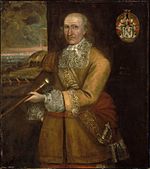
The oldest child Edward was baptised 28 May 1613. He signed the Portsmouth Compact and settled on Aquidneck Island with his parents, but he soon made peace with the Massachusetts authorities and returned to Boston. He was an officer in the colonial militia, and died from wounds received during King Philip's War. Susanna was baptised 4 September 1614 and died in Alford during the plague in 1630. Richard (baptised 8 December 1615) was admitted to the Boston church in 1634, but he returned to England and no further record has been found. Faith (baptised 14 August 1617) married Thomas Savage and lived in Boston, dying about 1651. Bridget (baptised 15 January 1618/9) married John Sanford and lived in Portsmouth, Rhode Island, where her husband was briefly governor of the island; after his death she became the third wife of William Phillips and had three sons, John Samuel and William. She died by 1698.
Francis (baptised 24 December 1620) was the oldest of the children to perish in the massacre in New Netherland. Elizabeth (baptised 17 February 1621/2) died during the plague in Alford and was buried there on 4 October 1630. William (baptised 22 June 1623) died during infancy. Samuel (baptised 17 December 1624) lived in Boston, married, and had a child, but left behind few records. Anne (baptised 5 May 1626) married William Collins, and both of them went to New Netherland and perished in the massacre with her mother. Mary (baptised 22 February 1627/8), Katherine (baptised 7 February 1629/30), William (baptised 28 September 1631), and daughter Zuriel (baptised in Boston 13 March 1635/6) were all children when they went with their mother to New Netherland, and were killed during the Indian massacre in the late summer of 1643. Susanna was the 14th child of the Hutchinsons and the youngest born in England, baptised 15 November 1633. She survived the Indian attack in 1643, was taken captive, and eventually traded to the English, after which she married John Cole and had 11 children with him.
Of Hutchinson's dozen or more siblings who survived childhood, only one other came to New England; her youngest sister, Katherine, the wife of Richard Scott, came to Boston and then Providence. With her husband, Katherine was a Puritan, Baptist, and then Quaker.
Descendants
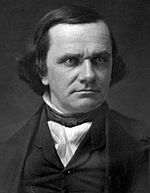
A number of Anne Hutchinson's descendants have reached great prominence. Among them are United States Presidents Franklin D. Roosevelt, George H. W. Bush, and George W. Bush, as are presidential aspirants Stephen A. Douglas, George W. Romney, and Mitt Romney. Her grandson Peleg Sanford was a governor of the Colony of Rhode Island and Providence Plantations. Other descendants include Chief Justice of the United States Supreme Court Melville Weston Fuller and Associate Justice Oliver Wendell Holmes, Jr.; Lord Chancellor of England John Singleton Copley, Jr., who was the first Lord Lyndhurst; President of Harvard University Charles William Eliot; actor Ted Danson; Musician Kaitlyn ni Donovan; and opera singer and socialite Madam Lillie Fay Moulton De Hegermann-Lindencrone. One descendant bearing the Hutchinson name was her great-great-grandson Thomas Hutchinson, who was a loyalist Governor of the Province of Massachusetts Bay at the time of the Boston Tea Party, an event leading to the American Revolutionary War.
Ancestry
In 1914, John Champlin published the bulk of the currently known ancestry of Anne Hutchinson, showing her descent on her father's side of the family from Charlemagne and Alfred the Great. Gary Boyd Roberts and others have published her line of descent on her mother's side from Edward I of England, thus connecting her with Edward's great grandparents, Henry II of England and his wife, Eleanor of Aquitaine. Most of the material in the following ancestor chart is from Champlin, except for the Williamson line which was published in The American Genealogist by F. N. Craig in 1992.
| Ancestors of Anne Hutchinson | ||||||||||||||||||||||||||||||||||||||||||||||||||||||||||||||||||||||||||||||||||||||||||||||||||||||||||||||||||||||||||||||||||||||||||||||||||||||||||||||||||||||||||||||||||||||||||||||||||||||||||||||||||||||||||||||||||||||||||||||||||||||||||||||||||||||||||||||||||||||||||||||||||||||||||||||||||||||||||||||||||||||||||||||||||||||||||||||||||||||||||||||||||||||||||||||||||||||||||||||||||||||||||||||||||||||||||||||||||||||||||||||||||||||||||||||||||||||||||||||||||||||||||||||||||||||||||||||||||||||||||||||||||||||||||||||||||||||||||||||||||||||||||||||||||||||||||||||||
|---|---|---|---|---|---|---|---|---|---|---|---|---|---|---|---|---|---|---|---|---|---|---|---|---|---|---|---|---|---|---|---|---|---|---|---|---|---|---|---|---|---|---|---|---|---|---|---|---|---|---|---|---|---|---|---|---|---|---|---|---|---|---|---|---|---|---|---|---|---|---|---|---|---|---|---|---|---|---|---|---|---|---|---|---|---|---|---|---|---|---|---|---|---|---|---|---|---|---|---|---|---|---|---|---|---|---|---|---|---|---|---|---|---|---|---|---|---|---|---|---|---|---|---|---|---|---|---|---|---|---|---|---|---|---|---|---|---|---|---|---|---|---|---|---|---|---|---|---|---|---|---|---|---|---|---|---|---|---|---|---|---|---|---|---|---|---|---|---|---|---|---|---|---|---|---|---|---|---|---|---|---|---|---|---|---|---|---|---|---|---|---|---|---|---|---|---|---|---|---|---|---|---|---|---|---|---|---|---|---|---|---|---|---|---|---|---|---|---|---|---|---|---|---|---|---|---|---|---|---|---|---|---|---|---|---|---|---|---|---|---|---|---|---|---|---|---|---|---|---|---|---|---|---|---|---|---|---|---|---|---|---|---|---|---|---|---|---|---|---|---|---|---|---|---|---|---|---|---|---|---|---|---|---|---|---|---|---|---|---|---|---|---|---|---|---|---|---|---|---|---|---|---|---|---|---|---|---|---|---|---|---|---|---|---|---|---|---|---|---|---|---|---|---|---|---|---|---|---|---|---|---|---|---|---|---|---|---|---|---|---|---|---|---|---|---|---|---|---|---|---|---|---|---|---|---|---|---|---|---|---|---|---|---|---|---|---|---|---|---|---|---|---|---|---|---|---|---|---|---|---|---|---|---|---|---|---|---|---|---|---|---|---|---|---|---|---|---|---|---|---|---|---|---|---|---|---|---|---|---|---|---|---|---|---|---|---|---|---|---|---|---|---|---|---|---|---|---|---|---|---|---|---|---|---|---|---|---|---|---|---|---|---|---|---|---|---|---|---|---|---|---|---|---|---|---|---|---|---|---|---|---|---|---|---|---|---|---|---|---|---|---|---|---|---|---|---|---|---|---|---|---|---|---|---|---|---|---|---|---|---|---|---|---|---|---|---|---|---|---|---|---|---|---|---|---|---|---|---|---|---|---|---|---|---|---|---|---|---|---|---|---|---|---|---|---|---|---|---|---|---|---|---|---|---|---|---|---|---|---|---|---|---|---|---|---|---|---|---|---|---|---|---|---|---|---|---|---|---|---|---|---|---|---|---|---|---|---|---|---|---|---|---|---|---|---|---|---|---|---|---|---|---|---|---|---|---|---|---|---|---|---|---|
|
||||||||||||||||||||||||||||||||||||||||||||||||||||||||||||||||||||||||||||||||||||||||||||||||||||||||||||||||||||||||||||||||||||||||||||||||||||||||||||||||||||||||||||||||||||||||||||||||||||||||||||||||||||||||||||||||||||||||||||||||||||||||||||||||||||||||||||||||||||||||||||||||||||||||||||||||||||||||||||||||||||||||||||||||||||||||||||||||||||||||||||||||||||||||||||||||||||||||||||||||||||||||||||||||||||||||||||||||||||||||||||||||||||||||||||||||||||||||||||||||||||||||||||||||||||||||||||||||||||||||||||||||||||||||||||||||||||||||||||||||||||||||||||||||||||||||||||||||
See also
 In Spanish: Anne Hutchinson para niños
In Spanish: Anne Hutchinson para niños
- Christian egalitarianism
- Christian views about women
- List of colonial governors of Rhode Island
- Mary Dyer


